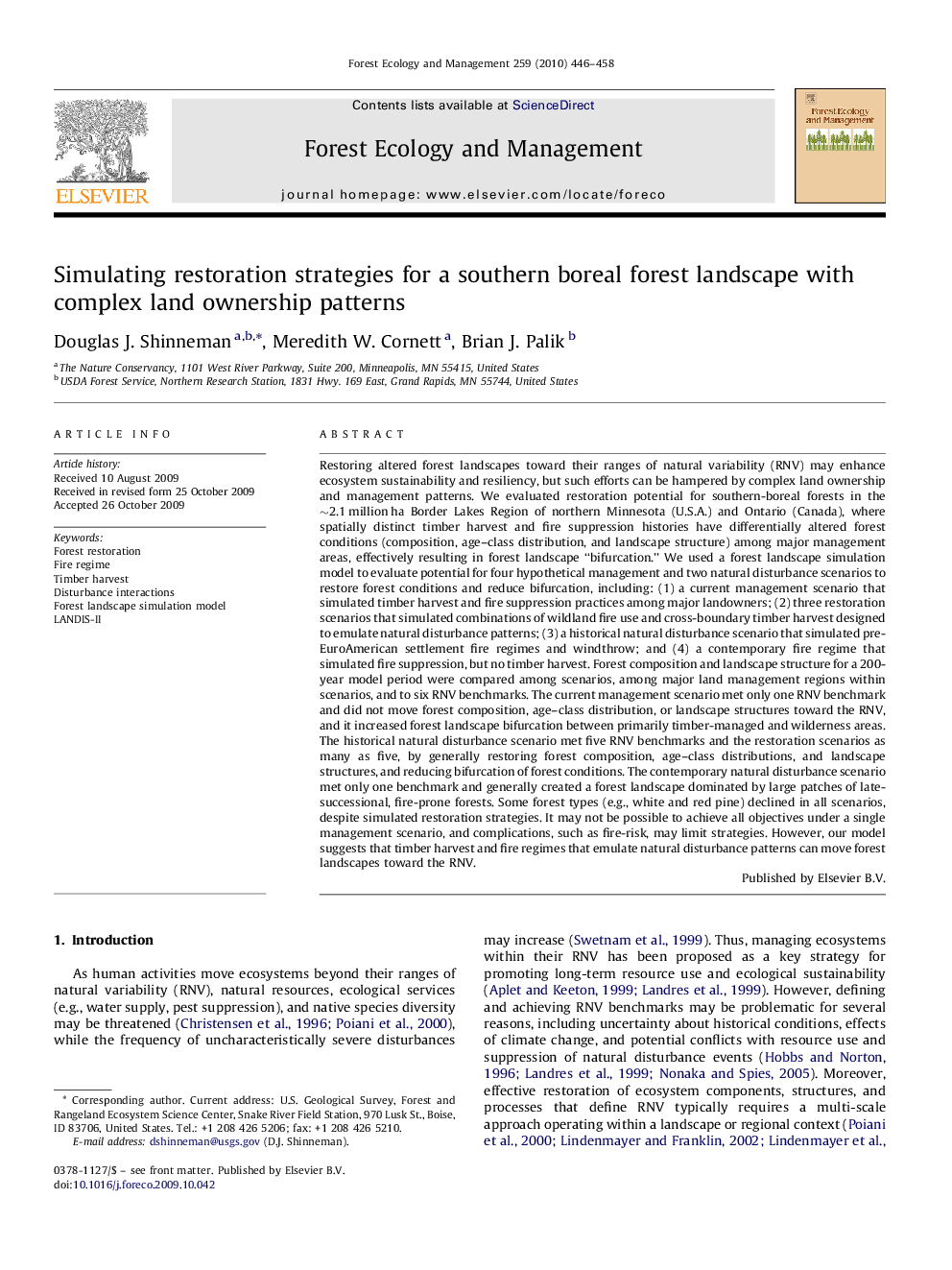| کد مقاله | کد نشریه | سال انتشار | مقاله انگلیسی | نسخه تمام متن |
|---|---|---|---|---|
| 10250579 | 159322 | 2010 | 13 صفحه PDF | دانلود رایگان |
عنوان انگلیسی مقاله ISI
Simulating restoration strategies for a southern boreal forest landscape with complex land ownership patterns
دانلود مقاله + سفارش ترجمه
دانلود مقاله ISI انگلیسی
رایگان برای ایرانیان
کلمات کلیدی
موضوعات مرتبط
علوم زیستی و بیوفناوری
علوم کشاورزی و بیولوژیک
بوم شناسی، تکامل، رفتار و سامانه شناسی
پیش نمایش صفحه اول مقاله

چکیده انگلیسی
Restoring altered forest landscapes toward their ranges of natural variability (RNV) may enhance ecosystem sustainability and resiliency, but such efforts can be hampered by complex land ownership and management patterns. We evaluated restoration potential for southern-boreal forests in the â¼2.1 million ha Border Lakes Region of northern Minnesota (U.S.A.) and Ontario (Canada), where spatially distinct timber harvest and fire suppression histories have differentially altered forest conditions (composition, age-class distribution, and landscape structure) among major management areas, effectively resulting in forest landscape “bifurcation.” We used a forest landscape simulation model to evaluate potential for four hypothetical management and two natural disturbance scenarios to restore forest conditions and reduce bifurcation, including: (1) a current management scenario that simulated timber harvest and fire suppression practices among major landowners; (2) three restoration scenarios that simulated combinations of wildland fire use and cross-boundary timber harvest designed to emulate natural disturbance patterns; (3) a historical natural disturbance scenario that simulated pre-EuroAmerican settlement fire regimes and windthrow; and (4) a contemporary fire regime that simulated fire suppression, but no timber harvest. Forest composition and landscape structure for a 200-year model period were compared among scenarios, among major land management regions within scenarios, and to six RNV benchmarks. The current management scenario met only one RNV benchmark and did not move forest composition, age-class distribution, or landscape structures toward the RNV, and it increased forest landscape bifurcation between primarily timber-managed and wilderness areas. The historical natural disturbance scenario met five RNV benchmarks and the restoration scenarios as many as five, by generally restoring forest composition, age-class distributions, and landscape structures, and reducing bifurcation of forest conditions. The contemporary natural disturbance scenario met only one benchmark and generally created a forest landscape dominated by large patches of late-successional, fire-prone forests. Some forest types (e.g., white and red pine) declined in all scenarios, despite simulated restoration strategies. It may not be possible to achieve all objectives under a single management scenario, and complications, such as fire-risk, may limit strategies. However, our model suggests that timber harvest and fire regimes that emulate natural disturbance patterns can move forest landscapes toward the RNV.
ناشر
Database: Elsevier - ScienceDirect (ساینس دایرکت)
Journal: Forest Ecology and Management - Volume 259, Issue 3, 25 January 2010, Pages 446-458
Journal: Forest Ecology and Management - Volume 259, Issue 3, 25 January 2010, Pages 446-458
نویسندگان
Douglas J. Shinneman, Meredith W. Cornett, Brian J. Palik,